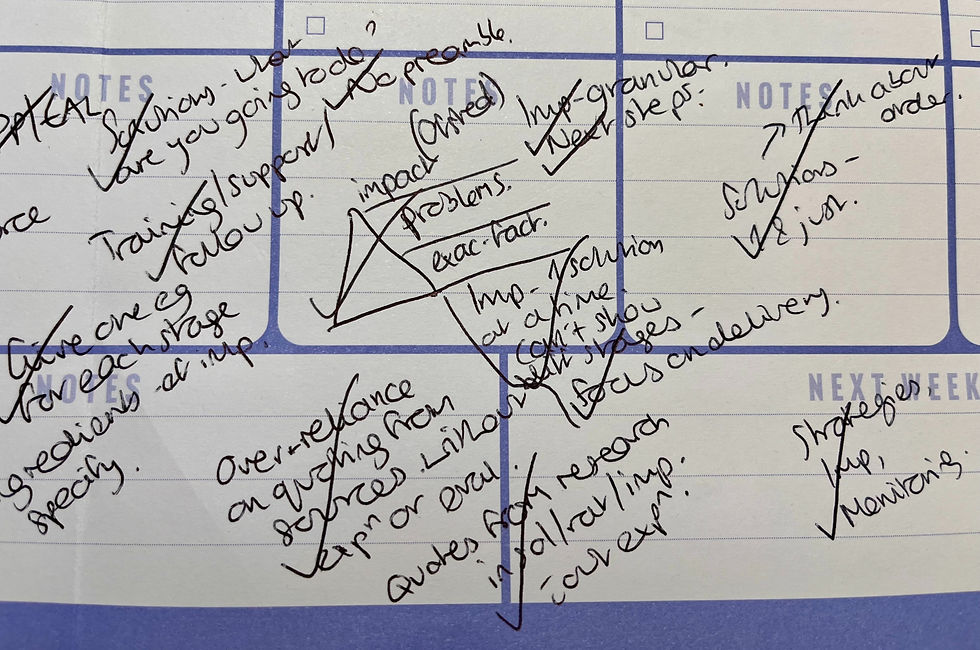NPQ Summative Assessment Tips
- becca86607
- Apr 4, 2024
- 4 min read
Updated: Aug 4

A great motto, one I try to live by, but on this occasion, my past self has let me down…
I spent some time last week going over my NPQ summative assessment support session ready to help colleagues ahead of the April window. As you may know 1 in 20 participants don’t meet the standard to pass, and as you only get one chance to retake, it’s vital to prepare thoroughly.
A key aspect of my own prep is to incorporate the things I noticed when assessing and moderating in the last window.

My notes, pictured here, certainly didn’t make that easy for me this time round, but I have finally managed to decipher the indecipherable, and here are my NPQ summative assessment tips, one for each section.
1. Identify the problem.
Try to differentiate between the exacerbating factors, the problems themselves and the impact of the problems (an idea helpfully illustrated with a small triangle in my notes).
What I mean here is that a lot of participants will spend many words describing the context of the school, especially if it has higher than national pupil premium or English as an additional language. While these are certainly more difficult circumstances, you can’t actually solve these “problems”, so I tend to think of them instead as exacerbating factors which I would suggest you reference towards the end of Part 1, and only if they are relevant to the problems themselves.
On the other hand, the impact of the problems is what has happened as a result of the issues within a setting, so this might be soft indicators like low staff morale, or student and parent dissatisfaction. You’ll probably also find reference to low student performance or widening gaps and, very often in the case studies, a recent ‘requires improvement’ Ofsted judgement.
Again though, you can’t directly solve these “problems” – they will be improved by the solutions you provide for the real problems, which I’d suggest you focus on.
2. Solutions and rationale
The most common mistake I see in this section is with the rationale. For some NPQ providers the rationale is addressed as a separate question, and for some it is included in the same section as the solutions. I think it’s more helpful to think of them very separately, because the rationale often gets forgotten as the participant shares the solutions which will allow them to fix the problems identified in Part 1.
Let’s say that one of your solutions is to implement a school-wide policy of recall activities to start every lesson. The rationale can’t just be that this is an issue at the moment and students report unsettled starts to lessons, for example. That will cause you to repeat yourself from Part 1, and every word needs to be used effectively when you’re working to such a strict word count.
Instead, in this example of recall activities, you could justify this solution by explaining:
· That both teachers and students will benefit from clear routines at the start of lessons that create a calm atmosphere conducive to learning (NPQSL LT4.9).
· How this supports the management of students’ cognitive load, with reference to Rosenshine’s first principle or Deans for Impact.
· EEF findings around simple, regular routines that support managing behaviour.
Ultimately, your rationale should show not just that your solution is an appropriate solution, but that it is the best solution.
3. Implementation
This is by far and away the section where most participants seem to struggle, and I totally understand why. There often seems to be a real temptation to repeat Part 2, and outline the solutions in even more detail, even going into specific logistics at times. But that’s not what the implementation section is about.
Implementation is all about how you’re going to explore, prepare, deliver and sustain the solutions.
Before writing this section, I’d suggest that you do the following:
· Go back to the implementation modules from your NPQ course and re-read the content and related research.
· Read through the implementation section in your NPQ framework – it’s section 8 for NPQSL: National professional qualifications frameworks - GOV.UK (www.gov.uk). The Learn How To statements are helpfully divided into the stages of implementation, so plan, choose, prepare, deliver, sustain.
· Remind yourself of the EEF’s implementation guidance: Implementation | EEF (educationendowmentfoundation.org.uk).
So as I continue trying to decipher my own notes from February, I hope you can use this advice in your upcoming summative assessment, and “Do something today that your future self will thank you for.”
If you feel like you need a bit more help preparing, you can have a look at how to apply the EEF's updated implementation guidance to your NPQ summative assessment here.
Or for advice on how to write with precision and clarity of voice in your NPQ summative assessment, click here.
I can also offer support that goes into much more detail on the following topics:
· Overall approach
· Features of successful responses for each section
· Common pitfalls for each section
If you were unfortunate enough not to pass last time and are retaking, I can take a detailed look at your responses and any feedback you’ve been given, and I can then offer tailored support to help you prepare this time and pass.

Comments